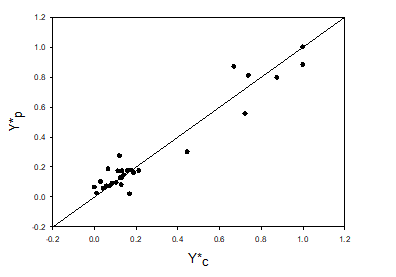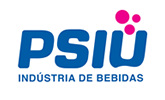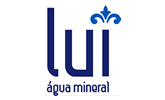Quantitative structure-activity relationship (QSAR) prediction of protic ionic liquids cytotoxicity toward HepG2 cell line.
ISBN 978-85-85905-23-1
Área
Química Verde
Autores
Andrade, R.S. (UNIVERSIDADE FEDERAL DO RECÔNCAVO DA BAHIA) ; Romão, G.B. (UNIVERSIDADE FEDERAL DA BAHIA) ; Barretto Cicarelli, R. (UNESP) ; Chiari-andrèo, B.G. (UNIARA) ; Iglesias, M. (UNIVERSIDADE FEDERAL DA BAHIA)
Resumo
Protic Ionic liquids (PILs) are innovative chemical compounds, which due to their peculiar nature, have been studied as potentially sustainable solvents in many areas of modern science. The aim of this study is to investigate the cytotoxicity of 13 recently synthesized PILs. In addition, due to the enormous number of possible combinations of anions and cations which can form ionic liquids, a group contribution Quantitative Structure Activity Relationship (QSAR) model has been used in order to predict their cytotoxicity. The estimated and experimental values were well correlated (correlation coefficient R2=0.927). The results showed that they have a remarkably low toxicity into the studied in-vitro systems.
Palavras chaves
Protic Ionic Liquids; Cytotoxicity; QSAR method
Introdução
Ionic liquids (ILs) are chemicals composed of ionic species poorly structured and coordinated, which are most often liquid below 100°C (WELTON, 1999). The Protic Ionic Liquids (PIL), a new family of ILs tailor-made for specific applications are synthesized from substituted amines as cations and organic deprotonated acids as anions, avoiding complex structures or potential hazardous molecular groups (GREAVES e DRUMMOND,2015). In silico methods such as QSAR (quantitative structure-activity relationship) can be used for predicting toxicity and thus reduce costly and time-consuming toxicity testing, either in vitro or in vivo (PERIC et al, 2015). The use of the QSAR modeling for the prediction of toxicity is recognized by REACH regulation (EUROPEAN UNION, 2006), stating that properties determined with the use of in silico methods are equivalent to laboratory testing. The QSAR modeling, as its name indicates, provides toxicity data based on the quantitative relationship between chemical structure and biological and/or toxicological activity, using chemical descriptors generated from the molecular structure. These descriptors are statistically analyzed in order to develop a model that would describe the desired activity e.g. toxicity. Until now, the QSAR studies on the toxicity of ILs have been far less frequent compared to other chemicals. In this work, we have evaluated the cytotoxicity of thirteen synthesized protic ionic liquids using hepatocytes HepG2 cell line. These data were compared with previously reported experimental data and then used to build a predictive toxicity model based upon the QSAR modeling method. The model was used to elucidate the chemical and structural factors that govern the toxicity of these compounds.
Material e métodos
The cytotoxic effect of the thirteen PIL was assessed by MTT assay using human hepatoma cells (HepG2). MTT is a water-soluble tetrazolium salt, which is converted to an insoluble purple dye by cleavage of the tetrazolium ring by succinate dehydrogenase within the mitochondria. This dye crystal is impermeable to the cell membranes and therefore it accumulates in healthy cells. In order to perform the QSAR modeling, a database of the IC50 values of ionic liquids for HepG2 cytotoxicity test was built, composed by the experimentally obtained IC50 values for our 13 PILs, and the remaining 15 IC50 values taken from the literature for ILs derived from disubstituted imidazolium, pyridazinium phosphonium and choline, and were selected in order to have a larger database of IC50 values. The QSAR model was based on the group contribution method, proposed by Luis et al. (2007) where molecular properties can be computed as a sum of the contributions of its atoms and/or fragments. Every ILs has been divided into basic groups, which can contribute to toxicity. The groups were encoded in a Boolean distribution, meaning that they are equal to 1 if the group is present in the ILs molecule and 0 if not. The IC50 values were converted into a logarithmic scale and the cytotoxicity was expressed as the calculated dimensionless cytotoxicity (Yc*), according to the following equation: Yc*=(logIC50max-logIC50)/(logIC50max- logIC50min) (1) where log IC50max and log IC50min are the highest and the lowest IC50 value in the IC50 database, respectively. The log IC50 is the logarithm of the experimentally obtained IC50 value. The predicted dimensionless toxicity (Yp*) used in this model represents the sum of the contributions of all of the groups present in the IL.
Resultado e discussão
The chemicals toxicity depends on its
permeation through the cells and
tissues and, also, on the mechanism of
action (interaction with cell
organelles, receptors, and pathways
triggered), which are strictly related
to the chemical structure. Thus, some
important details should be considered
to correlate PIL´s chemical structure with
their activity, such as the
toxicity of the cation/anion that composes
the PIL and the
hydrophilic/hydrophobic feature (partition
coefficient) of the molecule.
The dataset of 28 IC50 values was fitted
to the QSAR model by multiple
linear regression using Sigmaplot
software. The calculated dimensionless
toxicity obtained from experimental IC50
data and the predicted
dimensionless toxicity obtained after QSAR
modeling were plotted and the
data plot graph is shown in Fig. 1. A
reasonably good fitting was achieved,
with n = 28, R2 = 0.9270 and 15
descriptors. Residuals were calculated as
the differences between the calculated
dimensionless toxicity and predicted
by QSAR method (taking into account the
absolute values). The distribution
of the residuals in Table 1 and the plot
graph in Fig. 1 indicates that
there are practically no outliners and 75%
of the residuals are lower than
0.10. The most and the least toxic ILs
were well predicted by the model.

Calculated and predicted dimensionless citotoxicity dataplot for HepG2 assay.

Distribution of residuals between the calculated and predicted dimensionless toxicity and the mean residual for HepG2 cell assay.
Conclusões
The PILs' cytotoxicity revealed higher IC50 values when compared to imidazolium derivative ionic liquids assessed on similar cell types.31 These results should guide their use as solvents or additives for safe human use products, in agreement with the predictions, based on their designed chemical structure. The model based on group contribution (QSAR) used in this work allowed the prediction of protic ionic liquids' cytotoxicity, with a relative accuracy of experimental and then predicted toxicity data.
Agradecimentos
The authors would like to acknowledge Fundação de Amparo à Pesquisa do Estado da Bahia (FAPESB) for support this research.
Referências
WELTON, T. Room-Temperature Ionic Liquids. Solvents for Synthesis and Catalysis. Chem. Rev., 1999, 99, pp 2071-2084.
EUROPEAN UNION. 2006. Regulation (EC) No. 1907/2006 of the European Parliament and of the Council concerning the Registration, Evaluation, Authorization, and Restriction of Chemicals (REACH). Off J Eur Union 396:1–856.
GREAVES, T. L., DRUMMOND, C. J. Protic Ionic Liquids: Evolving Structure–Property Relationships and Expanding Applications. Chem. Rev., 2015, 115 (20), pp 11379–11448.
PERIC B., SIERRA J., MARTÍ E., CRUAÑAS R., GARAU M.A. Quantitative structure-activity relationship (QSAR) prediction of (eco)toxicity of short aliphatic protic ionic liquids. Ecotoxicol Environ Saf., 2015, 115, pp 257-262.











